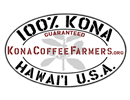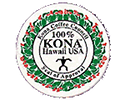You are here
Kona Coffee FAQ
Who introduced coffee to Hawaii and when?
A number of unsuccessful attempts were made … in 1813 Don Francisco de Paula y Marin planted seedlings on Oahu, in 1825 John Wilkinson who came on HMS Blonde brought plants from Brazil, others may have tried too.
Who introduced coffee to the Kona District and when?
The missionary Reverend Samuel Ruggles in 1828. The first commercial production is reported in 1845, just 248 pounds on the island of Kauai!
Who is the Greenwell family?
The Greenwell Family was and still is one of the important farmer/processors of Kona Coffee. In 1873, at the World’s Fair in Vienna, Henry Nicholas Greenwell received an award of Excellence which may be the foundation to the reputation of Kona Coffee. Today the family still owns one of the largest coffee operations in the Kona District.
Why does Kona Coffee taste so good?
Kona’s geography provides ideal growing conditions with morning sun and ample afternoon moisture … combined with well-drained, rich volcanic soils at elevations providing warm days and cool nights, nothing could make a coffee tree happier!
Why is Kona Coffee so expensive?
Kona coffee is rare, perhaps less than 4,000 acres are planted. Kona coffee comprises less the 1/10 of 1% of the world’s coffee production. Real estate in Hawaii is expensive, labor is expensive, all supplies and equipment, even fertilizer must come in by ship to Honolulu and then shipped again by barge to the Big Island of Hawaii … probably the most expensive place to grow coffee in the world!
What is the significance of 100% Kona Coffee vs. other Hawaii coffees?
Kona is a geographical term. Only coffee grown in the Kona District can be labeled Kona Coffee. If it is grown on Maui, it is Maui Coffee. If it is grown on the Big Island, but not in the Kona District is maybe Ka’u Coffee or Hawaiian Coffee, but not Kona Coffee.
What is the Kona Coffee Belt?
The Kona Coffee belt is an area approximately 26 miles in length and 3 miles wide, mostly between 700 feet and 2,000 feet of elevation. This is the region where growing conditions in the Kona District are ideal for growing gourmet coffee.
Is Kona Coffee grown on a volcano?
Yes! The entire Hawaiian Island chain is volcanoes, most are dormant, a few on the Big Island of Hawaii are active like Kilauea in Volcanoes National Park. Kona Coffee is grown on the slopes of Mauna Loa and Hualala’i mountains.
How many farms produce Kona Coffee?
Over 600
What species are Kona Coffee trees … are they all the same?
A few farmers experiment with other varieties, the vast majority are Arabica, var. Kona Typica which originated in Guatemala many years ago.
Is Organic coffee grown in Kona?
Some farms in the Kona District adhere to the strict standards established by the United States Department of Agriculture and are certified Organic.
Mountain Thunder Coffee Plantation is currently certified Organic for crops and crop processing.
Is coffee a fruit, nut or?
Coffee is a fruit that grows on a tree. The trees are often pruned to reduce height, improve yield and ease picking to the size of a large bush. The coffee bean is equivalent to the pit inside the coffee cherry fruit.
How old is a coffee tree before it has coffee fruit, and how long does a coffee tree live?
First commercial production usually occurs at about 3 – 4 years. Well cared for coffee trees live 50 – 60 years … perhaps 100 years.
When do the coffee trees flower?
This varies on elevation and rainfall, but typically the coffee trees flower in February and March. The abundant white flowers are often called “Kona Snow.”
How tall do coffee trees grow?
Untended coffee trees may reach 30 or 40 feet in height, most growers prune their trees regularly. The resulting trees are generally less than 15 feet tall.
When is the fruit ready to pick, what color is the fruit, how do you tell if it is ripe?
Ripe coffee cherries are bright to slightly dark red. Green and yellow is not ripe yet. Brown or black cherry is over-ripe.
Tell me about the Coffee Borer Beetle.
The borer beetle (Hypothenemus Hampei) is a worldwide problem for the coffee industry costing the industry hundreds of millions of dollars annually in lost production and attempts to control and eradicate. The beetle was first found in Kona in August 2010. Beetle-infested trees have both lower quality and lower quantity production. The beetle is extremely difficult to eliminate.
How do you tell a bad quality coffee cherry or bean?
From inspection of cherry … ripe (not over or under ripe) … evidence of beetle pin holes. Measuring and managing moisture content in the milling process and storage. Careful grading and sorting by size, density, and color for parchment and green coffee beans.
How is the fruit picked, how many pounds can a person pick in a day?
If the crop is abundant and the terrain is easy, probably 300 – 500 pounds. Much less in difficult conditions. Contract pickers often make 65 cents a pound for picking … a very difficult and demanding job!
How many pounds of coffee cherry does it take to make a pound of coffee?
About 4 ½ pounds of cherry yields a pound of parchment, there is another 20% weight loss when parchment is milled to green coffee, then another 18-20% weight loss in roasting. Considering these losses it takes about 7.4 pounds of coffee cherry to produce a pound of roasted coffee.
What happens to the waste fruit and other by-products?
Although the coffee cherry fruit is loaded with anti-oxidants and caffeine and has certain health benefits and has been used in lotions and creams … most are waste. Often being composted and returned to the land as mulch under the coffee trees to help control undergrowth and provide nutrients.
Some of the by-products of converting parchment to green coffee are used for horse bedding and mulch.
A limited amount of the coffee fruit skins are used to make a herbal tea.
How is it processed?
The initial process, in the wet mill, removes the fruit pulp from the coffee bean. The wet beans are then dried in a deck with natural sunlight or in propane fired drum driers. The resulting product is called parchment. The parchment then goes through a hulling process in the dry mill resulting in green coffee. Next, it is sorted by size and graded by density and color to produce quality roastable green coffee.
How long can it be stored?
Generally if stored properly parchment can be stored two years and green coffee can be stored a year without significant loss of quality. Perhaps the storage conditions and moisture content are more important than the length of time.
How is coffee graded, what are the grades?
Hawaii Department of Agriculture uses several grading criteria. Included are cleanliness (absence of foreign material), color, roasting quality, defects (insect pinholes, mold, odor, black color), size, and moisture content.
Extra Fancy are the largest beans 19/64” – up to 8 defects per 300 grams
Fancy - 18/64” – up to 12 defects per 300 grams
No. 1 - 16/64” – up to 18 defects per 300 grams
Select – Optional size – up to 5% defects
Prime – Optional size – up to 20% defects by weight. Lower grades are not permitted to use the word “Kona” in their description but are allowed to use “Hawaiian” in the description
Is coffee cherry fruit edible, is the green coffee bean edible?
Yes, raw skins taste like bell peppers and the coffee bean is covered with a sweet mucilage. Green coffee is not tasty!
What is the 10% Kona Coffee blend available in local stores?
100% Kona Coffee is expensive. Many tourist and budget focused retailers offer a 10% Kona Coffee blend, which is 10% Kona Coffee and 90% coffee from any other place in the world. The lower grades of Kona Coffee are used in these blends; it is unclear if adding 10% of lower grade Kona Coffee provides a noticeable improvement in taste. This product is NOT 100% Kona Coffee!
Where else in the U.S. and Hawaii is coffee grown?
Coffee is commercially grown in Puerto Rico and attempts are being made in Santa Barbara, CA. Coffee is commercially grown on almost all the Hawaiian Islands in addition to the Kona District.










